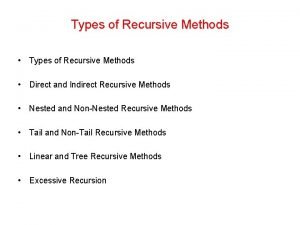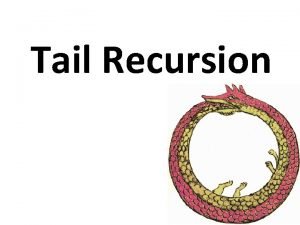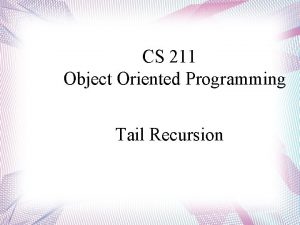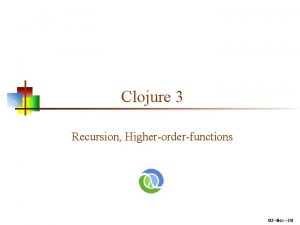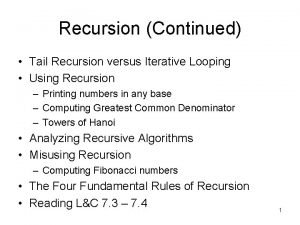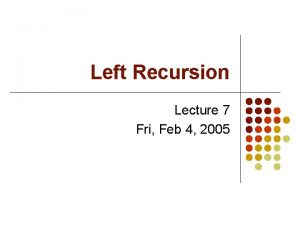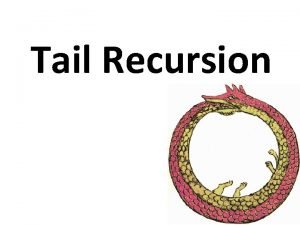Tail and Nontail Recursion Tail Recursion Definition Advantages










- Slides: 10

Tail and Non-tail Recursion • Tail Recursion? – Definition – Advantages of tail recursion – Converting to and from tail recursion • Indirect Recursion? – Definition – Examples

What is Tail Recursion? • Recursive methods are either – Tail recursive – Nontail recursive • Tail recursive method has the recursive call as the last statement in the method. • Recursive methods that are not tail recursive are called non-tail recursive

Is Factorial Tail Recursive? • Is the factorial method a tail recursive method? int fact(int x){ if (x==0) return 1; else return x*fact(x-1); } • When returning back from a recursive call, there is still one pending operation, multiplication. • Therefore, factorial is a non-tail recursive method.

Another Example • Is this method tail recursive? void tail(int i) { if (i>0) { system. out. print(i+"") tail(i-1) } It is tail recursive!

Third Example • Is the following program tail recursive? void non prog(int i) { if (i>0) { prog(i-1); System. out. print(i+""); prog(i-1); } } • No, because there is an ealier recursive call, other than the last one, • In tail recursion, the recursive call should be the last statement, and there should be no earlier recursive calls whether direct or indirect.

Advantage of Tail Recursive Method • Tail Recursive methods are easy to convert to iterative. void tail(int i){ if (i>0) { system. out. println(i+""); tail(i-1) } } void iterative(int i){ for (; i>0; i--) System. out. println(i+""); } • Smart compilers can detect tail recursion and convert it to iterative to optimize code • Used to implement loops in languages that do not support loop structures explicilty (e. g. prolog)

Converting Non-tail to Tail Recursive • A non-tail recursive method can be converted to a tail-recursive method by means of an "auxiliary" parameter used to form the result. • The technique is usually used in conjunction with an "auxiliary" function. This is simply to keep the syntax clean and to hide the fact that auxiliary parameters are needed. int fact_aux(int n, int result) { if (n == 1) return result; return fact_aux(n - 1, n * result) } int fact(n) { return fact_aux(n, 1); }

Converting Non-tail to Tail Recursive • A tail-recursive Fibonacci method can be implemented by using two auxiliary parameters for accumulating results. auxiliary parameters! int fib_aux ( int n , int next, int result) { if (n == 0) return result; return fib_aux(n - 1, next + result, next); } To calculate fib(n) , call fib_aux(n, 1, 0)

Converting Tail Recursive to Iterative F(x) { if (P(x)) return G(x); return F(H(x)); } • P(x) is true, the value of F(x) is the value of some other function G(x). Otherwise, the value of F(x) is the value of the function F on some other value, H(x) F(x) { int temp_x = x; while (P(x) is not true) { temp_x = x; x = H(temp_x); } return G(x); }

Converting Tail Recursive to Iterative int fact_aux(int n, int result) { if (n == 1) return result; return fact_aux(n - 1, n * result); } F(x) { if (P(x)) return G(x); return F(H(x)); } the function F is fact_aux x is composed of the two parameters, n and result the value of P(n, result) is the value of (n == 1) the value of G(n, result) is result the value of H(n, result) is (n -1, n * result) int fact_iter(int n, int result) { int temp_n; int temp_result; while (n != 1) { temp_n = n; temp_result = result; n = temp_n - 1; result = temp_n * temp_result; } return result; } F(x) { int temp_x = x; while (P(x) is not true) { temp_x = x; x = H(temp_x); } return G(x); }
